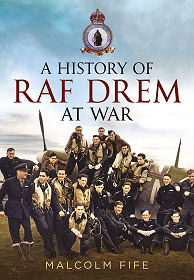 |
Some books can be read and enjoyed and immediately forgotten. Others have much more enduring appeal and value. "A History of RAF Drem at War" by Malcolm Fife falls into the second category. It is no exaggeration to say that this is a book that, now written, will always need to be referred to by anyone seeking to understand the events that took place here over a three decade period in the first half of the last century.
The book is all the more important because RAF Drem in East Lothian has largely been forgotten by history. It has suffered from its physical proximity to the much better known and better remembered RAF East Fortune, now home to Scotland's National Museum of Flight, which is ironic given the latter served as a satellite for Drem during the Second World War. Memories of RAF Drem have also faded much more easily than those of East Fortune because the infrastructure at Drem was so transient. It never had concrete runways, and most of the (many) buildings that served the grass airfield were removed after the Air Ministry declared it surplus to requirements in 1952.
Malcolm Fife's wonderfully researched, well written and nicely illustrated book opens with chapters on Drem (known at the time as West Fenton and then RAF Gullane) in the First World War and between the wars, but most of its contents deal in depth with RAF Drem (and HMS Nighthawk, which was its name during a period of use by the Fleet Air Arm) during the Second World War. It must have been tempting to organise the material chronologically, but instead the author has taken a series of themed strands, each telling the story of one of the different types of units that served here. One chapter looks at the auxiliary Spitfire squadrons of the RAF; while others look at the regular Spitfire squadrons, the Hawker Hurricane squadrons, the Whirlwinds and Typhoons, twin-engined night fighters, and the Bolton Paul Defiant squadrons. Chapters are also devoted to Free French Air Force units, Polish Squadrons, bomber units, and search and rescue units.
We also learn about RAF Drem itself, with chapters about the life of those based here, airfield defences, and innovations introduced here (particularly a system of airfield lighting named after Drem). As well as fixing RAF Drem's place in history, this book succeeds in a number of other ways. For a relatively "safe" place to be (especially compared with airfields in southern England during the Battle of Britain), flying from Drem was still a highly risky occupation. The threat of enemy bombers was ever present, but it becomes clear that the day to day dangers of flying in the 1940s were even greater, especially given the vagaries of Scottish weather, the unsuitability of many of the aircraft for night flying, and the perils of operating from an uneven and often boggy field. The reader also emerges with a sense of the constant turmoil caused by units moving from one location to another, often with bewildering frequency, and how unsettling that must have been for all those involved. But then, there was a war on.
InformationPaperback: 224 pagesFonthill Media fonthillmedia.com 21 January 2016 Language: English ISBN-10: 1781555230 ISBN-13: 978-1781555231 Size: 17.2 x 1.4 x 24.8 cm Buy from Amazon (paid link) Visit Bookshop Main Page |
